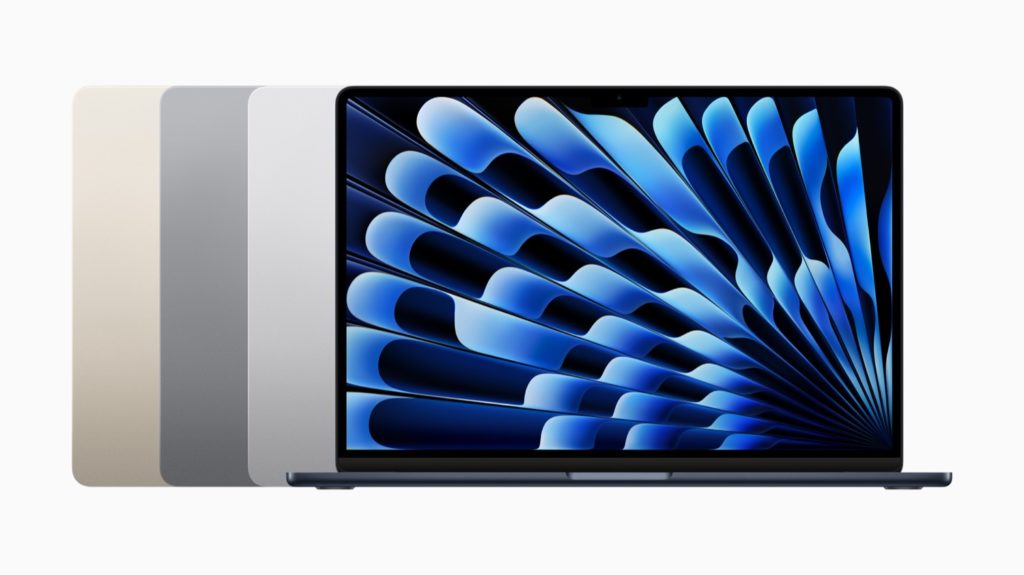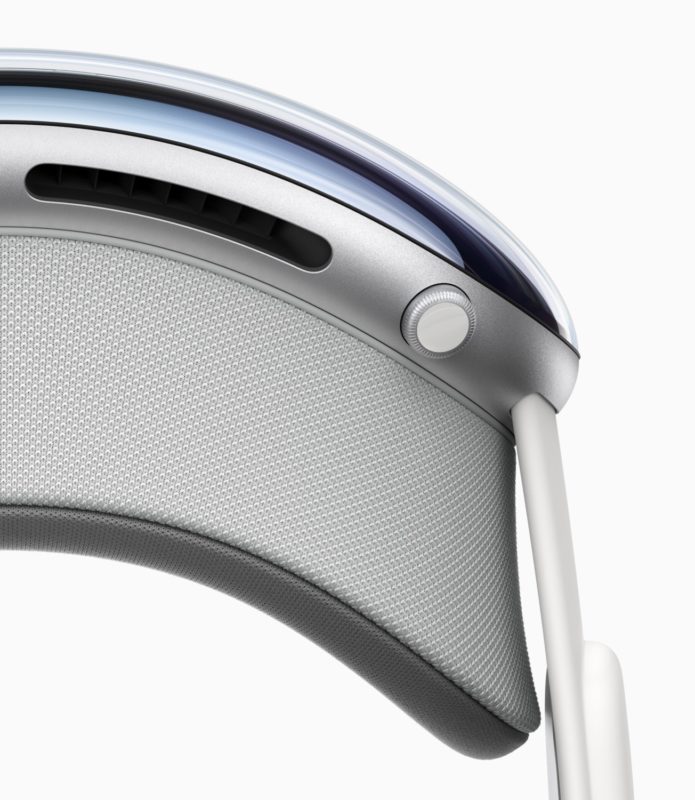After years of speculation and rumors, Apple have today shown their dream for the future of augmented reality with the announcement of Apple Vision Pro. As it won’t arrive until next year, at first in the US and later elsewhere, it feels like a statement of intent for the future rather than a product announcement, and indeed the videos looked more like science fiction than we’re used to. As it’s going to cost $3499, even more than the widely predicted $3000, it’s not going to be an immediately mainstream platform. That said, I can see something like this being very much a part of how many people choose to live and work going forward.
Before we head off into the details, I should say that I’m not at Apple Park, and I haven’t tried any of this tech in person. It’s notoriously difficult to demo any 3D or VR experience outside of the platform itself, so we’ll all have to wait — some of us longer than others — to experience everything that’s been shown for ourselves.
With that in mind, let’s first take a quick tour through the other announcements that might impact your day-to-day work life, long before you get your hands on an Apple Vision Pro.
MacBook Air with M2 and 15.3” display
It’s a MacBook Air with a bigger display for $1199, so if you don’t need a fully-specced portable Mac, this is a great option. While the MacBook Air doesn’t include the HDR display of the MacBook Pro, it’s a lot lighter at 3.3lb (1.51kg) and also a lot cheaper. While I’ve grown to love the one-Mac lifestyle with my M1 Max MacBook Pro 16”, for those who split their work across a desktop and laptop, this is a new compelling option.

Mac Studio with M2 Max and Ultra
This is a predictable but welcome upgrade, pushing a popular desktop to a new level of performance. There had been rumors that the revised Mac Studio would skip M2 entirely and wait for M3, but no; the M2 Max and M2 Ultra (essentially two M2 Max chips glued together) do provide a decent performance boost in common video apps. Apple’s performance claims usually stand up, and they’ve quoted 50% faster After Effects renders for the M2 Max over the M1 Max, while M2 Ultra similarly claims a 50% boost in DaVinci Resolve speed over M1 Ultra. Those numbers likely relate to GPU improvements, and there’s a more typical 25% boost quoted — roughly what users of the M2 Max on the MacBook Pro have experienced.
For really demanding users, you can now configure 192GB of RAM, which is exciting for anyone training huge machine learning models locally, but overkill for most of us. Video professionals can now 22 streams of 8K ProRes, which is an absurd amount of performance that most of us will never need. HDMI has been upgraded to the latest standard to handle 8K at 60Hz or 4K at 240Hz. It’s the same price as the last M1 Mac Studio, from $1999.
Mac Pro with M2 Ultra
It’s a measure of how jam-packed this presentation was that the Apple silicon Mac Pro was included so briefly as to nearly be an afterthought. It’s got the power of a top-spec Mac Studio, but all the PCI slots that remain unique to the Mac Pro in Apple’s lineup. If you really need those slots, you finally have an option with Apple silicon inside. There are eight Thunderbolt ports too. It’s not cheap at $6999, but this is a Mac for a small audience and it’ll be made in small quantities. The new Mac Pro concludes the Apple silicon transition, and if you’re still on an Intel Mac, it’s probably time to jump on board.
iOS, iPadOS, etc.
At this point, we’re 20 minutes into a keynote that ran for over two hours, and we’ve already had almost all the Mac-based pro video news. Final Cut Pro and Logic Pro for iPad did get a mention, there’s a new background removal for videoconferencing that integrates presenters very nicely, and yes, there are some very nice updates coming to iOS, iPadOS and macOS, but you’re not here for that. I’m going to skip right over it all and talk about the new headset, with a focus on what it means for video professionals.
Apple Vision Pro
This is a remarkable headset, unlike anything we’ve seen before. Just like when the iPhone was introduced, this feels like the future — or at least, a future. It would feel right at home in an episode of Black Mirror (one of the few cheery ones) or a movie like Swan Song or Ex Machina. While it superficially resembles ski goggles, as most current headsets do, it’s quickly obvious that there’s a lot more going on here.
First, there’s a screen inside the Vision Pro to show a realistic view the eyes of the wearer to people nearby, to minimize isolation. This screen is a curved panel with a lenticular lens to show the correct perspective to each nearby viewer, and it’s not filming your face, it’s showing a 3D model of your face — called a persona — created during initial setup. (It seems that this persona is also what’s shown to viewers while you’re in a FaceTime call.)
Inside the headset, you’ll see your environment by default, including people, but you can spin a dial to turn reality down and turn up a virtual world instead. You can place native visionOS apps anywhere you like in space — there are no “screens” here — as well as run iPhone and iPad apps. Multiple apps can run at once, and you just glance around to move between them. Macs can also play in this space; your Mac becomes a 4K display inside the headset, so you can use all your existing apps and do regular video production tasks on a display that can be resized to any size you wish. External keyboards and trackpads can be used, or you can use a virtual keyboard and gesture controls.
Apple have quoted 23 million pixels across both eyes, and the math works out to roughly 3840×2994 pixels (or 3400×3400) for each one. The promise is that even small text is sharp, and that’s going to be key for use as a productivity tool. As a point of comparison, each eye’s display on the Meta Quest Pro is 1800×1920, so the Vision Pro offers more than 3x the resolution.
While it doesn’t look like Mac apps will be able to break out of the virtual screen like iOS, iPadOS and visionOS apps can, hopefully that’ll happen eventually — and I’d like to see multiple Mac screen support too. But because most of Apple’s core apps will be native at launch, you will be able use the visionOS versions of Calendar, Mail and other productivity apps while keeping your complex video production apps on the Mac.
One small detail is that while the battery is external, lives in your pocket, and lasts for two hours, you can also plug in for all-day use. While I’m not sure you’d want to look through a headset all day, it’s an option. Apple is definitely positioning this as a work device, not just for personal consumption. Yes, you’ll be able to edit like Tom Cruise in Minority Report.
What does the Vision Pro mean for content consumption?
A major focus of the device is content consumption, and of course you’ll be able to make your virtual theater screen as big as you like, surrounded by reality or something more soothing. Fans of 3D movies will appreciate the support for 3D content like the latest Avatar movies, and the headset itself can capture 3D movies. Though the process of capturing these movies feels a little dystopian — smile and look at the headset, kids — I’m just glad we’re going to have a new way to capture and experience our lives that’s not simply on a 2D screen.
Vision Pro has widespread developer support, including the popular 3D environment Unity, and a wide variety of well-known games and apps have announced their availability already — including Microsoft Office, Pixelmator Pro, and others. If it’s on iPad, it’s not going to be a big process to adapt for visionOS, and apps will of course be available through a dedicated app store. I don’t know if Apple knows exactly what uses people are really going to put this to, but you’ll have plenty of choices.
And for content creation?
If you currently edit 2D video that’s delivered to standard screens, you’ll still be able to do that; this is just a new delivery platform that existing streaming solutions will support. While you’ll also be able to use it for creation, editing 2D videos in a Vision Pro if you want to, it’ll absolutely be the tool of choice for anyone who works in 3D. Since Mac and iPad apps can work in sync today, I can’t imagine why the Vision Pro wouldn’t be able to show a live 3D model alongside your 2D Mac display. That’s where I think this device will shine for high-end creative tasks — working with a complex Mac-based UI but able to see your output in space.
Will we be able to edit movies in 3D in a future Final Cut Pro? No idea, but my fingers are firmly crossed. And while there weren’t any explicit demos of 360° video or photo content, I’m sure there will be a number of apps to show it. If you’re a generalist, I suspect 3D skills are going to become important over the next few years. And it’s not like 3D or AR content is exclusive to the Vision Pro — you can deploy this content to iPhone and iPad as well. As ever, diversify as much as you can, because change is the only certainty.
Conclusion
This headset is wild, and it’s a perfect example of how Apple, through their focus on design and platform integration, is able to do what no other company can. It’s a fair criticism to say that it’s “too expensive” and it’s definitely not going to be a mass-market device. But this is an exploratory step into a new medium and (presumably) the first of many devices in a series.
The first Mac wasn’t cheap, but less than a decade later, the Mac LC put far more advanced tech into the hands of many more people. The first iPhone wasn’t a megahit, but smartphones changed the world in just a few years. Of course, future Apple headsets will, eventually, be cheaper, and more people will be able to afford it. But VR has been around for a while and is yet to really take off, so will it change the world?
Nobody knows, but this headset has done a few things differently. The resolution is a huge step up, you’re not nearly as isolated from your environment as in a typical VR headset, and it feels properly integrated with other Apple devices. Most importantly, since this is the first headset I could feasibly use for work and not just games, it’s the first one I’m truly excited about. I can’t wait to get my hands on this in person, I can’t wait to make things for it, and I’m excited that a virtual holodeck is finally, feasibly in my future.
If you’d like to know more, head to the Apple Events page and watch the WWDC keynote; the Vision Pro section is at about 1 hour and 20 minutes.


